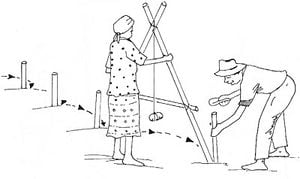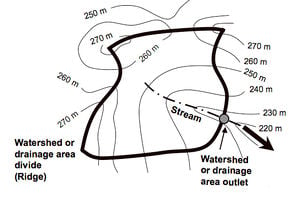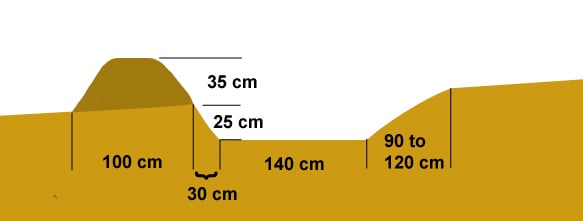
According to United Nations Environment Programme (UNEP), the volume of freshwater resources is about 2.5 per cent of the total volume of water on earth. Of this freshwater, only 30 per cent is stored in the form of groundwater which accounts for 97 per cent of all freshwater potentially available for human consumption.[1] However, much of the groundwater we rely on is slowly being depleted from underground aquifers through pumping. The overpumping of groundwater is causing water tables to fall across large areas of northern China, India, Pakistan, Iran, the Middle East, Mexico, and the western United States. Scientists have recently estimated in India that groundwater is being depleted across the country's north at a rate of 54 billion cubic meters per year. This is putting the nation's food supply and the region's 114 million people—are increasingly at risk.[2]
As a result of falling water tables, many rural communities around the world are facing problems such as increased pumping costs, drying up of wells, deterioration of water quality from salt water intrusion and reduction of water in streams and lakes. This is a result of a greater amount of water being withdrawn than deposited back into the aquifer. Groundwater recharge is what replenishes underground aquifers and can be increased through infiltration. Infiltration is the process of which of water on the ground surface enters the soil and flows into the unsaturated zone. The following information provides background information and design options for a small-scale infiltration system for the purpose of groundwater recharge. This system consists of constructing swales and berms to trap precipitation run-off and promote infiltration. A step-by-step design is provided as well as external links for additional information.
Background[edit | edit source]
Information is provided for general hydrology and hydrogeology considerations to aid in understanding the purpose of watershed management. The structures involved in swale design for watershed management are then described.
Hydrology[edit | edit source]

Watershed Delineation
A watershed is an area of land where surface water from precipitation drains into a body of water. This area also contains drainage areas in which water from a smaller portion of land drains through a downstream point. A drainage area is bounded by a divide, a line made up of a group of high points around the drainage area. To deliniate a drainage area, start with a contour map and draw a divide. The divide line runs through the highest points and is perpendicular to the contour lines on the map. An example is shown in the image on the right. At a smaller scale, delineation can be used to determine the drainage area for an infiltration trench or swale.
Infiltration
InfiltrationW is the process of water seeping through pore spaces in the subsurface soil due to gravity and capillary forces. During a storm, infiltration largely determines how much surface runoff is generated.
Surface Runoff
Surface RunoffW is the remaining portion of precipitation that becomes overland flow and accumulates in local streams and rivers. This excess water flow travels in a down-gradient direction and drains to a common point within a watershed. Runoff occurs when the soil had reached its maximum infiltration capacity.
Required Infiltration Area Using Surface Runoff
- R = runoff (m/hr)
- i = rainfall intensity (m/hr)
- f = infiltration rate of drainage area (m/hr) See Table 2
- D = depth of runoff (m)
- V = volume of runoff (m3)
- A = drainage area (m2)
- Ar = required infiltration area (m2)
- f = infiltration rate of swale material (m/hr)
The required infiltration area can be used to determine the dimensions of the swale:
- W = width (m)
- L = length of base (m)
The Water Budget
The basic components of the hydrological cycle include precipitation, evaporation, evapotranspiration, infiltration, overland flow, streamflow and groundwater flow. For a large watershed, a conceptual mathematical model of the overall hydrological budget is shown below. Using this model, the factors affecting groundwater recharge are identified.[3] This equation shows that storage will increase if surface runoff (R) decreases. It is also important to note that a change in storage is susceptible to factors such as precipitation, evaporation, and transpiration, all things which we have no control over.
P - R - G - E - T = S
- P = precipitation
- R = surface runoff
- G = groundwater flow
- E = evaporation
- T = transpiration
- S = change in storage in a specified period of time
Hydrogeology[edit | edit source]
Groundwater Flow
The groundwater flow is represented by Darcy's Law. These equations determine the speed at which the groundwater is flowing in the subsurface. This can help determine the rate at which groundwater recharge is occurring.
Where is the filtration velocity or Darcy flux (discharge per unit area, with units of length per time, m/s) and is the gradient vector.
The groundwater velocity () is related to the Darcy flux () by the porosity ().
Soil Permeability
Permeability is a measure of how easily a fluid, can pass through a porous medium such as soil. It is also governed by soil porosity which is the pore space between soil particles. The pore sizes and their connectivity determines whether a soil has high or low permeability. High porosity soils such as gravel and sand have high permeabilities which allow for greater amounts of infiltration. Low porosity soils such as clay have very low infiltration rates. The table below shows a range of permeability for various types of soils.
Table 1: Soil Permeability
| Permeability | Pervious | Semi-Pervious | Impervious | ||||||||||
| Unconsolidated Sand & Gravel | Well Sorted Gravel | Well Sorted Sand or Sand & Gravel | Very Fine Sand, Silt, Loess, Loam | ||||||||||
| Unconsolidated Clay & Organic | Peat | Layered Clay | Unweathered Clay | ||||||||||
| Consolidated Rocks | Highly Fractured Rocks | Oil Reservoir Rocks | Fresh Sandstone | Fresh Limestone, Dolomite | Fresh Granite | ||||||||
Geotechnical Structures[edit | edit source]
The combination of following structures can be used to increase infiltration of precipitation for the purpose of groundwater recharge. Further information can be found in Technical Specifications and Installation.
Swales
Swales are a type of structure that promote groundwater recharge. Similar to a trench, swales are dug into the ground in order to retain run-off water. The water then spreads and slows down allowing it to infiltrate into the subsurface. This creates a groundwater plume that replenishes underground aquifers and supports the growth of vegetation in areas down-gradient to the swale.
Berms
A berm is an earth barrier separating two areas of land that can be built to serve a variety of purposes. Berms are often used to control erosion and sedimentation by reducing the rate of surface runoff. As a result, berms either reduce the velocity of the water or direct water to areas that are not susceptible to erosion. This helps reduce adverse effects of running water on exposed topsoil. Berms are typically small mounds composed of soil, gravel or rocks and if well maintained can last for many years.
Regional Considerations[edit | edit source]
Groundwater recharge can significantly increase water supply levels in underground aquifers, however not all regions in the world use groundwater. Communities that are reliant on groundwater and face yearly decreases in water table levels will experience the most change from groundwater recharge. Benefits communities have seen in the past are listed beneath regions that can benefit.
Regions/Areas That Can Benefit[edit | edit source]
- Where geology favors the storing of water in underground aquifers and allows for it to be extracted.
- Riverine systems with high river flows during the monsoon season and experience a dry season.
- Where it is possible to conserve floodwater and flows are not used for crops and run out to sea.
- Locations where it is too expensive to build dams, to transport water over long distances or land cannot be allocated for storage.
- Areas with no soil salinity problems.
- Places where the ground slope varies gradually and where it is not subject to flooding and/or waterlogging.
- Ideal in places where accurate information on hydrogeology and groundwater movement are available.[4]
Most monsoon rains flood fields, filling rivers and streams with water that rushes out—unused—to the sea. This is the very water that could help the farmer year-round.[4]
Community Benefits of Groundwater Recharge[edit | edit source]
- Increases in net income per ha for farmers.
- Pumping cost savings from decreases in depth to water table.
- Families can create fertile land from previously dry areas.
- Increases in cropped area and irrigation potential.
- Reduction in energy use.
- Communities gain independence with a reliable water supply.
- Improved water quality from subsurface filtration.
Design Considerations[edit | edit source]
Location[edit | edit source]
Swales should be constructed along contour lines. This ensures the water will flow into the swale and not around it. The soils in the area should also be semi-pervious to allow for infiltration. The swale should also be placed down-gradient of areas with high runoff rates. This may include impervious surfaces such as roads, pathways or soils of low permeability.
Another important consideration is the location of the community's drinking water well. Any groundwater recharge that occurs as a result of the swales will move down-gradient towards the nearest surface water such as a small stream, river or lake. The groundwater tends to follow the topography of the land, allowing it to act as a general guideline for determining subsurface flow patterns. It is important that the well is located down-gradient of the swales in order for the underground aquifer to be replenished.
Slope[edit | edit source]
Swales are most effective when placed on a slope. This allows for efficient rainwater capture. A small incline is also an acceptable location because a slope of about 2.5 cm for every meter in length is enough to move water.[5] The swales can also be placed in sequence along the slope. Additional swales will capture any spillovers that occur uphill.
Soil Type[edit | edit source]
Three common types of soil include clay, sandy soil and loam. The following are described below.[6]
Clay
- When compacted and dry, clay is hard and forms large chunks. If wet, it is sticky and can be molded into shape.
- Clay and silt hold moisture well, but slow the downward movement of water and can stop water infiltration completely.
- If soil is heavily clay-based, sand and loam can be added to increase the infiltration rate.
- Clay is a low permeability material which makes it ideal for berm construction where it prevents the flow of water.
Sandy Soils
- Sandy soils contain large particles which are visible, and are usually light in color.
- Sand is coarse when wet or dry, and will not form a ball when squeezed together.
- Sandy soils allow for rapid water movement because the particles are large and loosely packed. Sandy soils stay loose and allow moisture to penetrate easily, but do not retain it for long term use.
- An inability to hold water and nutrients causes them to dry out quickly and a poor soil for vegetation.
- If the soil is very sandy, clay and loam can be added to help promote plant growth.
Loam
- Loam soil is a mix of sand, silt or clay, and organic matter.
- These soils are loose and look rich. If squeezed, moist loam will form a ball which crumbles when moved.
- Loam is the best soil for healthy vegetation because it absorbs water and stores moisture well.
- Loam is also semi-pervious which allows for infiltration.
The following table shows percolationW rates for different soil types.It is recommended that loam with a percolation rate of 15 mm/h is the minimum used for an infiltration swale. The water will not be able to infiltrate at a fast enough rate to increase groundwater recharge if infiltration rate is too low.
Table 2: Minimum Soil Infiltration Rates[7]
| Soil Type | Infiltration Rate (mm/h) |
|---|---|
| sand | 210 |
| loamy sand | 60 |
| sandy loam | 25 |
| loam | 15 |
Required Materials and Tools[edit | edit source]
Swales and berms are relatively easy to construct and do not require a large amount of materials or tools. To dig the swale, a shovel or any other type of digging tool can be used to remove soil. A measuring tool might also be useful for determining the depth and side slopes of the swale and berm.
For material used to form the berm, low permeability soils such as clay and rocks are recommended. Once dug, the swales can be filled in with bulk materials such as leaves, rotten wood or straw. High permeability material such as gravel can also be used. Usually materials found in the surrounding region are used in the construction of these structures.
Technical Specifications[edit | edit source]
The following images are cross-sectional models of the structures in the inflitration system.
Infiltration on Level Ground[edit | edit source]

Infiltration on Inclined Areas[edit | edit source]
This image is a conceptual model for combining a swale and a berm for the creation of an infiltration system. This is a cross section of the swale and it is shown located on a slope, with the run-off flow in the direction of the structure.

The following swale was designed by Dan Palmer for an arid climate and can be used as a guideline.[8] The measurements can be flexible and a length greater than 2m is recommended.

Installation[edit | edit source]

- Swales should be constructed on contour to the landscape. Contour lines can be determined using an A-frame. When an A-frame is placed on the land, level ground is located when the string is in the center of the frame. You can use the A-frame to map level areas along the ground. Along the level point, place stakes as markers. At the end, you will have marked out a contour line.
- As a rough guide, contour lines can be marked out 20 meters apart. Once the contours have been marked out decide how many swales to install. The swales should be placed down-gradient of areas that produce runoff such as roads. If there are no impervious surfaces in the area, the swales can be built at different levels along a slope or at lower elevations where more water will accumulate.
- Once you have marked out the location of your swales, you can start digging. Swales are recommended to be at least 2 to 3 meters in length and 50 cm deep. When digging it is important not to compact the soil in the trench because this will reduce the infiltration capacity of the soil.
- After the general shape of the swale has been formed, mix up the material in the bottom of the trench. If there low permeability material in the trench, you can consider digging an additional depth of 0.5m and filling it with more permeable materials. This will improve the infiltration rate of the swale.
- Use the excavated material to create a berm along the downhill side. This will help catch water in the swale during intense rainfall events. The core of the berm can be compacted while looser materials can be layered on top. The permeable layers will provide further runoff capture and infiltration while the impermeable core will prevent surface runoff from travelling further downhill.
- Piling up stones or gravel along the uphill side of the berm will reduce erosion from water flows, especially if high water flows are going to occur during the wet season.
- If desired, the area just downhill of the berm can be vegetated with seedlings, seed or sod. This will help prevent erosion and in the future, the vegetation may be able shade the swale and reduce evaporation. Infiltration from the swale will make the soils more suitable for plant life in areas down-gradient of its location.
Estimated Costs[edit | edit source]
It's recommended that materials from the surrounding area be used in the construction of the swales and berms. A basic swale does not have a cost because it only involves the digging of a trench and relocating the material into a berm next to the swale. Additional soil materials such as rocks and high permeability soils can be bought if they are not available in the area. Their cost will depend on a number of factors including the location of the swale. Vegetation can also be bought once the swale is constructed but price and type of plant will vary depending on geographical location.
The cost of a small dam structure using locally available materials is estimated at US$ 200-400 compared to a percolation pond structure that is estimated at US$ 5000 - 10000.[9] Swale construction can be physically demanding without the use of machines but it is very affordable and an efficient option for groundwater recharge.
References[edit | edit source]
- ↑ Vital Water Graphics, United Nations Environmental Programme, http://web.archive.org/web/20101006032714/http://www.unep.org:80/dewa/assessments/ecosystems/water/vitalwater/01.htm
- ↑ National Geographic, http://web.archive.org/web/20161127175917/http://environment.nationalgeographic.com:80/environment/freshwater
- ↑ Bedient, P.,Huber, C. & Vieux, B. (2008) Hydrology and Floodplain Analysis,Prentice Hall.
- ↑ 4.0 4.1 Innovations in Groundwater Recharge, http://www.iwmi.cgiar.org/Publications/Water_Policy_Briefs/PDF/wpb01.pdf
- ↑ Do It Yourself: Vegetated Swale, http://web.archive.org/web/20101009031247/http://www.riversides.org:80/websitefiles/diy_vegetatedswale.pdf
- ↑ Toronto Homeowner's Guide to Rainfall, http://web.archive.org/web/20160313033651/http://riversides.org/rainguide/riversides_hgr.php?cat=&page=73&subpage=&subpage2=
- ↑ Stormwater Management Planning and Design Manual 2003, http://www.ene.gov.on.ca/envision/gp/4329e_4.htm
- ↑ Water Catchment Strategies for Drylands, http://permaculturetokyo.blogspot.com/2007/03/water-catchment-strategies-for-drylands.html
- ↑ Technologies for water harvesting and soil moisture conservation in small watersheds for small-scale irrigation, http://www.fao.org/docrep/w7314e/w7314e0q.htm
See also[edit | edit source]
- Permaculture (Note that swales are an important part of water management in permaculture.)
External Links[edit | edit source]
Video on Permaculture Water Harvesting
Video on Greening the Desert
Video of Swales in Landscape
The Water Cycle










